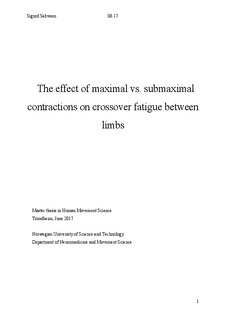| dc.description.abstract | Background: When targeting increased muscle strength, resistance training is revered as the ideal method of achieving this goal. Emerging amounts of evidence indicates that to increase muscular strength, exerting the muscle to a fatiguing point may be required, and that not only the trained muscle can achieve strength increases. When a different muscle than the one being trained achieves a training effect, this phenomenon is known as cross-education. When muscle fatigue is transferred, this is called crossover fatigue, which could link to cross-education, and may not be the same for contralateral limbs as ipsilateral limbs.
Aims: To determine whether the amplitude of crossover fatigue remains the same for both the contralateral and ipsilateral limb, and to compare the effects of maximal versus submaximal fatiguing tasks. Additionally, both central and peripheral factors were investigated.
Method: 18 participants (age 21.8 ± 1.1 years) volunteered for the study, and completed Three different testing sessions in the laboratory; a control session, a maximal fatiguing session and a submaximal fatiguing session. Measurements of MVC and electrical stimulation (twitch) were taken prior to (PRE) and after (POST) exercise on the right leg (exercised limb, EL) and left leg (contralateral limb, CL), with only MVC measurements of the right arm (ipsilateral limb, IL).
Results: MVC force output significantly declined by 38 % in the exercised leg during both the maximal and submaximal fatiguing session. During the maximal session, no fatigue was documented in either the contralateral nor the ipsilateral limb. During the submaximal session, a decline of 6 % was found in both the contralateral limb and the ipsilateral limb, although the decline was not statistically significant for the contralateral limb. The twitches were reduced by 21 and 10 % for the exercised limb during the two sessions, while interestingly, the contralateral limb twitch force increased by 20 and 18 %. No significant changes were found in voluntary activation.
Conclusion: This study found a significant difference in effect between the maximal and submaximal fatiguing task in the ipsilateral limb, as well as a trend in the contralateral limb, both being in favor of the submaximal fatiguing session. Central mechanisms appear to be the main cause of crossover fatigue. There is also an implication that a compensating factor, like antagonistic activation, may have played a part in the decreases in force output, which could explain the results. | nb_NO |
